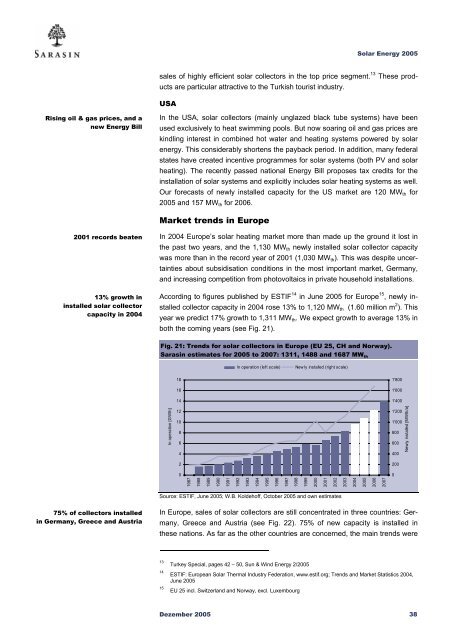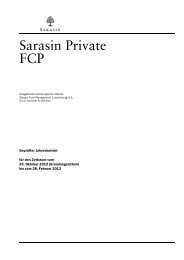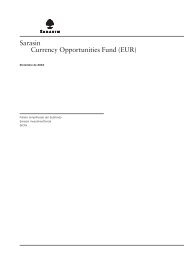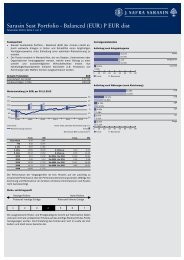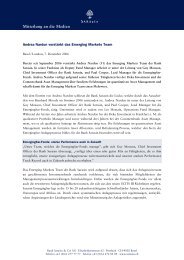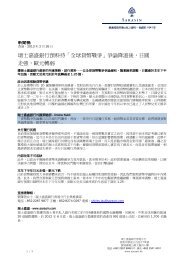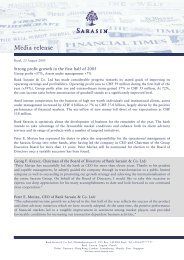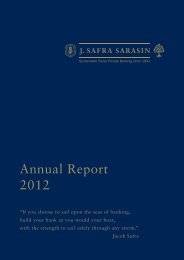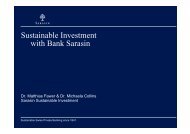Sustainability Report - Bank Sarasin-Alpen
Sustainability Report - Bank Sarasin-Alpen
Sustainability Report - Bank Sarasin-Alpen
You also want an ePaper? Increase the reach of your titles
YUMPU automatically turns print PDFs into web optimized ePapers that Google loves.
Solar Energy 2005<br />
sales of highly efficient solar collectors in the top price segment. 13 These products<br />
are particular attractive to the Turkish tourist industry.<br />
USA<br />
Rising oil & gas prices, and a<br />
new Energy Bill<br />
In the USA, solar collectors (mainly unglazed black tube systems) have been<br />
used exclusively to heat swimming pools. But now soaring oil and gas prices are<br />
kindling interest in combined hot water and heating systems powered by solar<br />
energy. This considerably shortens the payback period. In addition, many federal<br />
states have created incentive programmes for solar systems (both PV and solar<br />
heating). The recently passed national Energy Bill proposes tax credits for the<br />
installation of solar systems and explicitly includes solar heating systems as well.<br />
Our forecasts of newly installed capacity for the US market are 120 MW th for<br />
2005 and 157 MW th for 2006.<br />
Market trends in Europe<br />
2001 records beaten<br />
13% growth in<br />
installed solar collector<br />
capacity in 2004<br />
In 2004 Europe’s solar heating market more than made up the ground it lost in<br />
the past two years, and the 1,130 MW th newly installed solar collector capacity<br />
was more than in the record year of 2001 (1,030 MW th ). This was despite uncertainties<br />
about subsidisation conditions in the most important market, Germany,<br />
and increasing competition from photovoltaics in private household installations.<br />
According to figures published by ESTIF 14 in June 2005 for Europe 15 , newly installed<br />
collector capacity in 2004 rose 13% to 1,120 MW th (1.60 million m 2 ). This<br />
year we predict 17% growth to 1,311 MW th . We expect growth to average 13% in<br />
both the coming years (see Fig. 21).<br />
Fig. 21: Trends for solar collectors in Europe (EU 25, CH and Norway).<br />
<strong>Sarasin</strong> estimates for 2005 to 2007: 1311, 1488 and 1687 MW th<br />
In operation (left scale) New ly installed (right scale)<br />
In operation [GWth]<br />
18<br />
16<br />
14<br />
12<br />
10<br />
8<br />
6<br />
4<br />
2<br />
1'800<br />
1'600<br />
1'400<br />
1'200<br />
1'000<br />
800<br />
600<br />
400<br />
200<br />
Newly installed [MWth/a]<br />
0<br />
0<br />
1987<br />
1988<br />
1989<br />
1990<br />
1991<br />
1992<br />
1993<br />
1994<br />
1995<br />
1996<br />
1997<br />
1998<br />
1999<br />
2000<br />
2001<br />
2002<br />
2003<br />
2004<br />
2005<br />
2006<br />
2007<br />
Source: ESTIF, June 2005; W.B. Koldehoff, October 2005 and own estimates<br />
75% of collectors installed<br />
in Germany, Greece and Austria<br />
In Europe, sales of solar collectors are still concentrated in three countries: Germany,<br />
Greece and Austria (see Fig. 22). 75% of new capacity is installed in<br />
these nations. As far as the other countries are concerned, the main trends were<br />
13<br />
14<br />
15<br />
Turkey Special, pages 42 – 50, Sun & Wind Energy 2/2005<br />
ESTIF: European Solar Thermal Industry Federation, www.estif.org; Trends and Market Statistics 2004,<br />
June 2005<br />
EU 25 incl. Switzerland and Norway, excl. Luxembourg<br />
Dezember 2005 38


